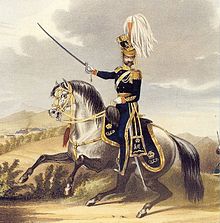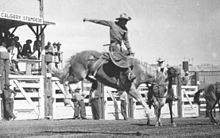Canadian Equestrian Team
 The 1948 Mann Logo | |
| Founded | 1840 |
|---|---|
| Colours | Red and White |
The Canadian Equestrian Team or CET (French: Équipe équestre canadienne or EEC) collectively describes the athletes that represent Canada at the highest levels of international equestrian competition, specifically at the World Championship, Olympic, and Paralympic levels.
There many different equestrian disciplines, with separate and overlapping international governing bodies, responsible for different international championship series. Because of this, the term Canadian Equestrian Team has been used by many equestrian sport organizations since 1840 to describe their most senior teams competing for Canada internationally in a variety of disciplines and in a variety of systems.
When greater precision is needed, a specific team is referred to by its discipline or by the event at which it competes: e.g., the athletes riding for Canada in jumping at the Olympic Games are referred to variously as the "Canadian Equestrian Team", the "Canadian Jumping Team", the "Canadian Olympic Equestrian Team", and the "Canadian Olympic Jumping Team".[1]
History
[edit]Origins
[edit]
The earliest recorded Canadian Equestrian Team competed at the 1840 Montreal Steeplechase, the first international steeplechase competition in North America. Capt Walter Jones of the Queen's Light Dragoons was the sole CET rider, and represented The Canadas against riders from British regiments.[2] The event was won by Colonel Whyte of Britain's 7th Hussars.[3]
Canada's first national equestrian championship, the "Dominion Equestrian Championship", was held in 1895 in Toronto, in the disciplines of steeplechase, hunt seat equitation, and jumping, with entries from both men and women.[4] Although the victors were the first group of athletes to be described as the Canadian Equestrian Team, they did not go on to compete together internationally.
Military Age
[edit]In the first half of the twentieth century, international equestrian sport was dominated by military riders. In Canada, the Canadian Militia (later renamed as the Canadian Army) was recognized by the federal government as the country's first national equestrian federation, and began the process of building the first institutional CET.
The first CET that was organized as a formal multi-athlete team to compete together at an international event, was a group of jumpers, selected by the Canadian Militia for the 1909 Military Tournament at the Olympia London International Horse Show. The riders were: Lt Wood Leonard (London Field Battery); Lt Frank Proctor (Governor General's Bodyguard); and Capt Douglas Young (Royal Canadian Dragoons). They finished in fourth place. This team was, however, considered a representative of the Canadian military and not of Canada itself, because it competed only against other military teams.[5]
The first group of athletes who were regarded as representatives of all Canadian equestrians (both civilian and military) and who competed together against other national equestrian teams, was selected by the Canadian Militia to compete in Prix des Nations jumping at the 1926 Royal Agricultural Winter Fair in Toronto. The team was composed of Maj R S Timmis, Lt Elliott, and Capt Stuart Bate. All three riders were from the Royal Canadian Dragoons, the only Canadian cavalry regiment to retain horses after the First World War. The team won first place, defeating national teams from Belgium, Britain, France, and the United States.[6]
The team went on to compete successfully against other international opponents in New York, Boston, and London.[5]
Growth
[edit]After the end of the Second World War, the Canadian Army began phasing out its financial support for equestrian sport. Today, the Canadian Armed Forces exercises responsibility for the CET only at the CISM Military World Games.[7]

The shrinking role of the eastern-Canada based military coincided with a burst of CET activity in western-Canada. Pete Knight became the CET's first World Champion in 1932, as the RAA World Champion Bronc Rider. He would repeat the feat in 1933, 1935, and 1936, and was popularly known as the CET's "King of the Cowboys".[8]
The end of centralized control of the CET also caused a series of inter-related civilian groups to come in and out of being, as equestrian sport began a period of significant but disorganized growth across Canada.
In 1948, Major General CC Mann founded the Canadian Equestrian Society (CES), in an effort to create a single organizing focus for Canada's eventing and jumping teams. Although the CES lasted only two years, it put in place many of the factors that would continue to define the CET to the present.
The CES initiated planning for Canada's Olympic equestrian debut at the 1952 Helsinki Games, it created the maple leaf and horseshoe team emblem, and it popularized the term "Canadian Equestrian Team". Critically, when Major General Mann dissolved the CES in 1950, he placed its material and intellectual assets in the public domain. This enabled others to complete the process of building Canada's first Olympic equestrian team, made the Mann logo the most widely used emblem for Canada's international equestrians across all disciplines and all organizations, and made "Canadian Equestrian Team" a unifying term over a fragmented and constantly changing horse sport system.[6]
Olympic Debut
[edit]After the end of the CES, the Canadian Horse Shows Association (CHSA) provided bridging funding to CET athletes, until Major LJ McGuinness founded the Canadian Olympic Equestrian Team (COET) in 1951, to manage Canada's first participation in the Olympic equestrian events. The COET was largely run by the athletes themselves and their immediate supporters: Major McGuinness also captained and rode for the Canadian eventing team at the 1952 Helsinki Olympics.[9]
It was not until 1959 that a formal Canadian Olympic Equestrian Committee (COEC) corporation was created, with RH Rough serving as its first Executive Director. Since then, there has been a steady expansion in the number and the scale of professional organizations responsible for different CET disciplines.
The CET won its first Olympic medal in 1956, a team bronze in eventing. It won its first Olympic gold medal in 1968, a team gold in jumping.[9] It won its first team World Championship in 1970, by its team at the FEI Jumping World Championship.
Achievements
[edit]
The CET achieved its greatest success to date in 2010, when Canada was frequently described as one of the top three equestrian nations.[10]
At that time, CET athletes simultaneously held six separate World, Olympic, and Paralympic championships: the FEI Reining World Championship (Duane Latimer and Hang Ten Surprise);[11] the FEI Tent Pegging World Championship (Akaash Maharaj and Gagan);[12] the PRCA Steer Wrestling World Championship (Lee Graves);[13] the WCJA Jousting World Championship (Shane Adams and Dragon);[14] the IOC Jumping Olympic Championship (Eric Lamaze and Hickstead);[15] and the IPC Dressage II Freestyle Paralympic Championship (Lauren Barwick and Maile).[16]
World, Olympic, and Paralympic Champions
[edit]| Year | Championship | Athletes | Governing Body |
|---|---|---|---|
| 2009 | Steer Wrestling World Championship | Lee Graves (various) | PRCA |
| 2008 | Paralympic Dressage II Freestyle | Lauren Barwick (Maile) | IPC |
| 2008 | Olympic Jumping | Eric Lamaze (Hickstead) | IOC |
| 2008 | Tent Pegging World Championship | Akaash Maharaj (Gagan) | FEI |
| 2006 | Reining World Championship | Duane Latimer (Hang Ten Surprise) | FEI |
| 1994 | Steer Wrestling World Championship | Blaine Pederson (various) | PRCA |
| 1986 | Jumping World Championship | Gail Greenough (Mr T) | FEI |
| 1978 | Eventing World Championship | Elizabeth Ashton (Sunrise), Juliet Bishop (Sumatra), Mark Ishoy (Law and Order), Cathy Wedge (Abracadabra) | FEI |
| 1970 | Jumping World Championship | James Day (Canadian Club), Moffat Dunlap (Argyll), Jim Elder (Shoeman), Thomas Gayford (Big Dee) | FEI |
| 1968 | Olympic Jumping | James Day (Canadian Club), Jim Elder (The Immigrant), Thomas Gayford (Big Dee) | IOC |
| 1933 | Bareback Riding World Championship | Nate Waldron (unrecorded) | RAA |
| 1932, 1933, 1935, 1936 | Saddle Bronc World Championship | Pete Knight (various) | RAA |
CET Governing Bodies
[edit]There are currently fifteen independent national governing bodies in Canada governing CET athletes in international competitions. The three largest are Equine Canada for the Olympic and Paralympic teams, the Canadian Professional Rodeo Association for rodeo and western riding teams, and Polo Canada for the Canadian polo team.
References
[edit]- ^ "PADY, Walter James Obituary". The Globe and Mail. 11 August 2010. Retrieved 22 October 2013.
- ^ Cooper, John Irwin (1953). The History of the Montreal Hunt 1826-1953. Montreal: Montreal Hunt.
- ^ "Steeplechase in Montreal". American Turf Register, Baltimore. December 1840.
- ^ Schrodt, Barbara. "Equestrian Sports". The Canadian Encyclopedia. Historica - Dominion Institute. Archived from the original on July 30, 2012. Retrieved 22 October 2013.
- ^ a b Debbie, Gamble-Arsenault (2004). Legendary Show Jumpers: The Incredible Stories of Great Canadian Horses. Altitude Publishing. ISBN 978-1551539805.
- ^ a b May, Zita Barbara (1975). Canada's International Equestrians. Toronto: Burns & MacEarchern Limited.
- ^ "International Sports". Canadian Forces. Canadian Forces Sport. Retrieved 22 October 2013.
- ^ "Pete Knight: Canada's Cowboy King". Crossfield Pete Knight Days. Crossfield Rodeo Society. Archived from the original on 2013-10-29. Retrieved 22 October 2013.
- ^ a b "Oh Canada". Equine Canada Magazine. June–July 2012.
- ^ "The Articles of Chivalry". Equine Canada Magazine. March 2010.
- ^ "Duane Latimer: Canada's Reining Royalty". HorseJournals.com. Horse Community Journals Inc. Retrieved 22 October 2013.
- ^ "UNICEF Team Canada Triumphs". HorseLife Magazine. March 2008.
- ^ "Pro Rodeo Steer Wrestling World Champions 1929-200". World of Rodeo. World of Rodeo. Archived from the original on 2013-10-29. Retrieved 22 October 2013.
- ^ "Shane Adams". Knights of Valour. Knights of Valour. Retrieved 22 October 2013.
- ^ "Eric Lamaze". Athlete Biographies. Canadian Olympic Committee. Retrieved 22 October 2013.
- ^ Barwick, Lauren. "How I Got To Be Where I Am Now". Parelli Central Blog. Parelli Natural Horsemanship. Archived from the original on 2013-10-29. Retrieved 23 October 2013.
External links
[edit]- Canadian Armed Forces Morale and Welfare Services
- Canadian Cowboy Mounted Shooters Association
- Canadian Long Distance Riding Association
- Canadian Professional Chuckwagon Racing Association
- Canadian Professional Rodeo Association
- Canadian Universities Riding Clubs Association
- Equine Canada
- Horseball Canada
- Joust Canada
- National Barrel Horse Association Canada
- Polo Canada
- Polocrosse Canada
- Reining Canada
- Tent Pegging Canada
- Le TREC au Canada[permanent dead link]
